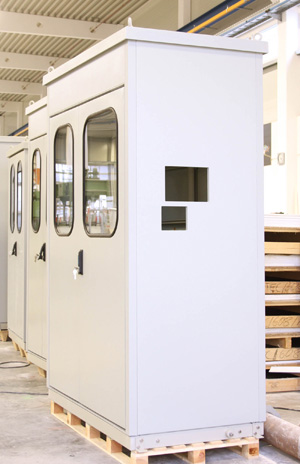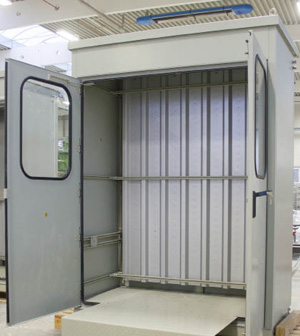Prelude, Shell’s floating liquefied natural gas project, will set sail on a 25-year mission, heralding new engineering records. Passively cooled purpose-built cabinets will protect sample conditioning and process analyser instrumentation on the vessel. We bring you the details.
Prelude, Shell’s floating liquefied natural gas project, will set sail on a 25-year mission, heralding new engineering records. Passively cooled purpose-built cabinets will protect sample conditioning and process analyser instrumentation on the vessel. We bring you the details.

Custom instrumentation protection cabinets that Intertec is producing for Shell’s Prelude FLNG project are designed to withstand Category 5 cyclones
Shell’s Prelude floating liquefied natural gas (FLNG) project is designed specifically for extended service life in hazardous areas. Due to enter service in 2017, the vessel will be towed to the Prelude and Concerto gas fields in the Browse Basin near Timor, about 200 kilometre off the northwest coast of Australia, where it will permanently be anchored for about 25 years. After this time, it will be inspected, overhauled and possibly moved to a new location, where it will be expected to provide a further 25 years of service.
Already setting new engineering records, the vessel has been designed to liquefy natural gas extracted from subsea wells by chilling it to -162 °C, and to then store the liquid until it is offloaded to large LNG carriers. The vessel is claimed to be the largest in the world, with a length of 488 metres and a width of 74 metres. The hull of the vessel was reportedly constructed in South Korea and launched in December 2013.
Apart from the intrinsic high points of the project, it is also of interest to the HVACR world, as it requires high-performance environmental protection cabinets. Intertec, designer and manufacturer of enclosures, has revealed that much of the on-line process analysis instrumentation on the Prelude FLNG vessel will be housed in purpose-built environmental protection cabinets supplied by it. The company says that in total, it is supplying 90 cabinets for sample conditioning systems and 30 cabinets for process analysers, each designed to precisely match the instrumentation content and layout in order to optimise thermal performance.
Designed specifically for extended service life in hazardous areas, the shelters incorporate innovative semi-passive cooling technology and are some of the most stringently specified instrumentation protection solutions that it has ever produced, the company has claimed.
The company gave some of the interesting highlights of the cabinets:

Semi-passive cooling technology is fi tted into each instrumentation protection cabinet that Intertec has produced for Shell’s Prelude fLNG project-avoiding the need for expensive and large explosion-proof air conditioning equipment
From a cooling point of view, which is the main focus, the cabinets reportedly offer interesting details.
Each of the cabinets is said to incorporate a unique form of semi-passive cooling technology. The size of each cabinet depends on the power dissipation of the contained sample conditioning or process analyser system, which ranges from 140 W to 900 W. Confirming this, Hans Geiger, Intertec’s Commercial Director, reveals, “Only three of the 120 cabinets that Intertec is supplying for this project are the same size.”
The internal face of the cabinets’ rear walls are fitted with a high-efficiency heat exchanger, comprising one or more aluminium cooling plates and stainless steel coolant pipes connected to Prelude’s cold water supply system, which obtains cold water from the deep sea by a 150-metre-long pipe below the vessel, the company elaborates. Heat dissipated by the equipment in the cabinets is absorbed by the water and transferred to the vessel’s main water cooling system, where it is, in turn, dissipated into the environment. This form of distributed cooling, says Intertec, has enormous technical and economic advantages, especially in hazardous areas or where space and weight are at a premium. It provides a very efficient means of removing heat from the cabinets without requiring local air conditioning systems, which would necessarily need to be explosion proof and, therefore, expensive, the company highlights.
Furthermore, transferring heat from individual air conditioners of below-deck cabinet installations to the ambient environment would be a major challenge and would involve significant amounts of space-consuming air ducting, the manufacturer asserts, and points out that the semi-passive cooling system is inherently safe for use in a hazardous environment. At the cabinet level, it requires little or no electrical power of its own and is virtually maintenance-free, making it ideal for long life-cycle applications, it adds.
Intertec, as is Shell, are not unaware of the significant challenges the intended operating environment for Prelude poses for instrumentation protection. The Browse Basin is admittedly very close to the Equator, which means that it has a tropical climate with an average temperature of about 32°C. This moist and hot environment, combined with a salt-laden atmosphere, is highly conducive to rust formation. In light of this, non-metallic protection cabinets is a sensible design choice, believes Intertec. In some of Prelude’s more confined spaces, the ambient temperature could reportedly reach more than 50°C. Even under these extreme conditions, the company claims it is confident that all of the passively cooled cabinets that it is producing for the project are designed to keep their internal air temperature below 35°C. Only time – or more precisely 25 years – will tell.
Copyright © 2006-2025 - CPI Industry. All rights reserved.